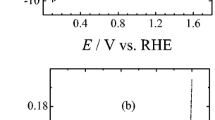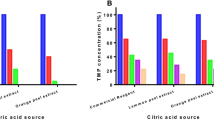Abstract
In this work, the effect of supporting electrolytes on the simultaneous electrochemical oxidation of the pharmaceuticals sulfamethoxazole (SMX), propranolol (PRO), and carbamazepine (CBZ) in aqueous solutions has been studied. Based on the identified by-products, the degradation mechanisms were proposed and the acute toxicity was evaluated for each electrolyte. Assays were carried out in batch mode in a 2 L undivided reactor using a niobium coated with boron-doped diamond (Nb/BDD) mesh anode and Ti cathode at 2.5 A in presence of different supporting electrolytes (Na2SO4, NaCl, or NaBr) at the same concentration of 7 mM. The degradation rates were higher in the assays with NaCl and NaBr. Reaction by-products were identified by gas chromatography–mass spectrometry. Indirect oxidation by electrogenerated reactive halogen species (RHS) was the main mechanism when halide ions were used as electrolytes. Ten by-products were detected using Na2SO4 as electrolyte, while 19 (12 non-halogenated and 7 halogenated) and 20 (10 non-halogenated and 10 halogenated) using NaCl and NaBr respectively. The proposed degradation pathways involve transformation (hydroxylation, deamination, desulfonation, and halogenation) and bond rupture to produce less molecular weight compounds and their further transformation until total degradation. Chlorinated and brominated by-products confirm halogenation reactions. The electrogenerated RHS presented a significant inhibition effect on Vibrio fischeri; nevertheless, acute toxicity was not presented using Na2SO4 as electrolyte and a pharmaceutical concentration of 5 μg/L. In this view, the role of the supporting electrolyte in electrochemical oxidation process is crucial since it strongly influence degradation rate, by-products, and acute toxicity.



Similar content being viewed by others
References
Al Aukidy M, Verlicchi P, Jelic A, Petrovic M, Barcelo D (2012) Monitoring release of pharmaceutical compounds: occurrence and environmental risk assessment of two WWTP effluents and their receiving bodies in the Po Valley. Italy. Sci Total Environ 438:15–25
Ammar HB, Brahim MB, Abdelhédi R, Samet Y (2016) Green electrochemical process for metronidazole degradation at BDD anode in aqueous solutions via direct and indirect oxidation. Sep Purif Technol 157:9–16
Benner J, Salhi E, Ternes T, von Gunten U (2008) Ozonation of reverse osmosis concentrate: kinetics and efficiency of beta blocker oxidation. Water Res 42:3003–3012
Brillas E, Sirés I (2012) Electrochemical remediation technologies for waters contaminated by pharmaceutical residues. Environmental chemistry for a sustainable world. Springer, Dordrecht, pp 297–346
Cleuvers M (2005) Initial risk assessment for three beta-blockers found in the aquatic environment. Chemosphere 59:199–205
De la Cruz N, Dantas RF, Giménez J, Esplugas S (2013) Photolysis and TiO2 photocatalysis of the pharmaceutical propranolol: solar and artificial light. Appl Catal B Environ 130-131:249–256
Deborde M, von Gunten U (2008) Reactions of chlorine with inorganic and organic compounds during water treatment-kinetics and mechanisms: a critical review. Water Res 42:13–51
Díaz-Cruz MS, Barceló D (2008) Input of pharmaceuticals, pesticides and industrial chemicals as a consequence of using conventional and non-conventional sources of water for artificial groundwater recharge. Hdb Env Chem vol 5 Part S/2. Springer-Verlag Berlin, Heidelberg, pp 219–238
Ding S, Niu J, Bao Y, Hu L (2013) Evidence of superoxide radical contribution to demineralization of sulfamethoxazole by visible-light-driven Bi2O3/Bi2O2CO3/Sr6Bi2O9 photocatalyst. J Hazard Mater 262:812–818
Dirany A, Efremova Aaron S, Oturan N, Sires I, Oturan MA, Aaron JJ (2011) Study of the toxicity of sulfamethoxazole and its degradation products in water by a bioluminescence method during application of the electro-Fenton treatment. Anal Bioanal Chem 400:353–360
Dirany A, Sires I, Oturan N, Oturan MA (2010) Electrochemical abatement of the antibiotic sulfamethoxazole from water. Chemosphere 81:594–602
Dong H, Qiang Z, Yuan X, Luo A (2018) Effects of bromide and iodide on the chlorination of diclofenac: accelerated chlorination and enhanced formation of disinfection by-products. Sep Purif Technol 193:415–420
Dzialowski EM, Turner PK, Brooks BW (2006) Physiological and reproductive effects of beta adrenergic receptor antagonists in Daphnia magna. Arch Environ Contam Toxicol 50(4):503–510
Frontistis Z, Antonopoulou M, Yazirdagi M, Kilinc Z, Konstantinou I, Katsaounis A, Mantzavinos D (2017) Boron-doped diamond electrooxidation of ethyl paraben: the effect of electrolyte on by-products distribution and mechanisms. J Environ Manag 195:148–156
Ganiyu S, Oturana N, Raffy S, Esposito G, van Hullebusch ED, Cretin M, Oturana MA (2017) Use of sub-stoichiometric titanium oxide as a ceramic electrode in anodic oxidation and electro-Fenton degradation of the beta-blocker propranolol: degradation kinetics and mineralization pathway. Electrochim Acta 242:344–354
Gao YQ, Gao NY, Yin DQ, Tian FX, Zheng QF (2018) Oxidation of the b-blocker propranolol by UV/persulfate: effect, mechanism and toxicity investigation. Chemosphere 201:50–58
García-Espinoza JD, Gortares-Moroyoqui P, Orta-Ledesma MT, Drogui P, Mijaylova-Nacheva P (2016) Electrochemical removal of carbamazepine in water with Ti/PbO2 cylindrical mesh anode. Water Sci Technol 73:1155–1165
García-Espinoza JD, Mijaylova-Nacheva P, Avilés-Flores M (2018) Electrochemical carbamazepine degradation: effect of the generated active chlorine, transformation pathways and toxicity. Chemosphere 192:142–151
Gómez-Ramos MM, Mezcua M, Aguera A, Fernandez-Alba AR, Gonzalo S, Rodriguez A, Rosal R (2011) Chemical and toxicological evolution of the antibiotic sulfamethoxazole under ozone treatment in water solution. J Hazard Mater 192:18–25
Grebel JE, Pignatello JJ, Mitch WA (2010) Effect of halide ions and carbonates on organic contaminant degradation by hydroxyl radical-based advanced oxidation processes in saline waters. Environ Sci Technol 44:6822–6828
Guzmán-Duque FL, Palma-Goyes RE, González I, Peñuela G, Torres-Palma RA (2014) Relationship between anode material, supporting electrolyte and current density during electrochemical degradation of organic compounds in water. J Hazard Mater 278:221–226
Heeb MB, Criquet J, Zimmermann-Steffens SG, von Gunten U (2014) Oxidative treatment of bromide-containing waters: formation of bromine and its reactions with inorganic and organic compounds-a critical review. Water Res 48:15–42
Homem V, Santos L (2011) Degradation and removal methods of antibiotics from aqueous matrices-a review. J Environ Manag 92:2304–2347
Kim Y, Choi K, Jung J, Park S, Kim PG, Park J (2007) Aquatic toxicity of acetaminophen, carbamazepine, cimetidine, diltiazem and six major sulfonamides, and their potential ecological risks in Korea. Environ Int 33:370–375
Komtchou S, Dirany A, Drogui P, Bermond A (2015) Removal of carbamazepine from spiked municipal wastewater using electro-Fenton process. Environ Sci Pollut Res 22:11513–11525
Kovalova L, Siegrist H, Singer H, Wittmer A, McArdell CS (2012) Hospital wastewater treatment by membrane bioreactor: performance and efficiency for organic micropollutant elimination. Environ Sci Technol 46:1536–1545
Li Y, Qiao X, Zhang YN, Zhou C, Xie H, Chen J (2016) Effects of halide ions on photodegradation of sulfonamide antibiotics: formation of halogenated intermediates. Water Res 102:405–412
Li Y, Zhang B, Liu X, Zhao Q, Zhang H, Zhang Y, Ning P, Tian S (2018) Ferrocene-catalyzed heterogeneous Fenton-like degradation mechanisms and pathways of antibiotics under simulated sunlight: a case study of sulfamethoxazole. J Hazard Mater 353:26–34
Lin T, Chen W, Cai B (2016) Inactivation mechanism of chlorination in Escherichia coli internalized in Limnoithona sinensis and Daphnia magna. Water Res 89:20–27
Lürling M, Sargant E, Roessink I (2006) Life-history consequences for Daphnia pulex exposed to pharmaceutical carbamazepine. Environ Toxicol 21(2):172–180
Magazinovic RS, Nicholson BC, Mulcahy DE, Davey DE (2004) Bromide levels in natural waters: its relationship to levels of both chloride and total dissolved solids and the implications for water treatment. Chemosphere 57:329–335
Martinez-Huitle CA, Ferro S (2006) Electrochemical oxidation of organic pollutants for the wastewater treatment: direct and indirect processes. Chem Soc Rev 35(12):1324–1340
Merouani S, Hamdaoui O, Saoudi F, Chiha M (2010) Influence of experimental parameters on sonochemistry dosimetries: KI oxidation, Fricke reaction and H2O2 production. J Hazard Mater 178(1-3):1007–1014
Niu J, Zhang L, Li Y, Zhao J, Lv S, Xiao K (2013) Effects of environmental factors on sulfamethoxazole photodegradation under simulated sunlight irradiation: kinetics and mechanism. J Environ Sci-China 25:1098–1106
Ofoegbu PU, Lourenço J, Mendo S, Soares AM, Pestana JL (2018) Effects of low concentrations of psychiatric drugs (carbamazepine and fluoxetine) on the freshwater planarian Schmidtea mediterranea. Chemosphere 217:542–549. https://doi.org/10.1016/j.chemosphere.2018.10.198
Panizza M (2010) Importance of electrode material in the electrochemical treatment of wastewater containing organic pollutants. Electrochemistry for the Environment. Springer, New York, pp 25–54
Pinkston KE, Sedlak DL (2004) Transformation of aromatic ether-and amine-containing pharmaceuticals during chlorine disinfection. Environ Sci Technol 38(14):4019–4025
Pretto PRP, Palácio SM, de Campos ÉA, Pazini CR, Veit MT (2018) Sulfamethoxazole photocatalytic degradation in a continuous flow reactor using artificial radiation. J Environ Chem Eng 6:1926–1933
Radjenovic J, Petrovic M, Barcelo D (2007) Analysis of pharmaceuticals in wastewater and removal using a membrane bioreactor. Anal Bioanal Chem 387:1365–1377
Richard J, Boergers A, Vom Eyser C, Bester K, Tuerk J (2014) Toxicity of the micropollutants bisphenol a, ciprofloxacin, metoprolol and sulfamethoxazole in water samples before and after the oxidative treatment. Int J Hyg Environ Health 217:506–514
Rivera-Jaimes JA, Postigo C, Melgoza-Alemán RM, Aceña J, Barceló D, de Alda ML (2018) Study of pharmaceuticals in surface and wastewater from Cuernavaca, Morelos, Mexico: occurrence and environmental risk assessment. Sci Total Environ 613:1263–1274
Rivera-Utrilla J, Sanchez-Polo M, Ferro-Garcia MA, Prados-Joya G, Ocampo-Perez R (2013) Pharmaceuticals as emerging contaminants and their removal from water A review. Chemosphere 93:1268–1287
Rosal R, Rodriguez A, Perdigon-Melon JA, Petre A, Garcia-Calvo E, Gomez MJ, Aguera A, Fernandez-Alba AR (2010) Occurrence of emerging pollutants in urban wastewater and their removal through biological treatment followed by ozonation. Water Res 44:578–588
Santos LH, Gros M, Rodriguez-Mozaz S, Delerue-Matos C, Pena A, Barcelo D, Montenegro MC (2013) Contribution of hospital effluents to the load of pharmaceuticals in urban wastewaters: identification of ecologically relevant pharmaceuticals. Sci Total Environ 461-462:302–316
Scialdone O, Randazzo S, Galia A, Silvestri G (2009) Electrochemical oxidation of organics in water: role of operative parameters in the absence and in the presence of NaCl. Water Res 43(8):2260–2272
Sim WJ, Lee JW, Lee ES, Shin SK, Hwang SR, Oh JE (2011) Occurrence and distribution of pharmaceuticals in wastewater from households, livestock farms, hospitals and pharmaceutical manufactures. Chemosphere 82:179–186
Silvey JD, Arey JS, Tentscher PR, Roberts AL (2013) Reactivity of BrCl, Br2, BrOCl, Br2O, and HOBr toward dimethenamid in solutions of bromide + aqueous free chlorine. Environ Sci Technol 47(3):1330–1338
Verlicchi P, Al Aukidy M, Galletti A, Petrovic M, Barcelo D (2012) Hospital effluent: investigation of the concentrations and distribution of pharmaceuticals and environmental risk assessment. Sci Total Environ 430:109–118
Von der Ohe, de Zwart D (2013) Toxic Units (TU) Indicators. Encyclopedia of Aquatic Ecotoxicology. Springer, Dordrecht, pp 1161–1170
Von Gunten U (2003) Ozonation of drinking water: part II. Disinfection and by-product formation in presence of bromide, iodide or chlorine. Water Res 37(7):1469–1487
Wang WL, Wu QY, Huang N, Wang T, Hu HY (2016) Synergistic effect between UV and chlorine (UV/chlorine) on the degradation of carbamazepine: influence factors and radical species. Water Res 98:190–198
Yang Y, Cao Y, Jiang J, Lu X, Ma J, Pang S, Li J, Liu Y, Zhou Y, Guan C (2018) Comparative study on degradation of propranolol and formation of oxidation products by UV/H2O2 and UV/persulfate (PDS). Water Res 149:543–552. https://doi.org/10.1016/j.watres.2018.08.074
Yargeau V, Huot JC, Rodayan A, Rouleau L, Roy R, Leask RL (2008) Impact of degradation products of sulfamethoxazole on mammalian cultured cells. Environ Toxicol 23:492–498
Zeng Y, Fu XE, Ren Z (2012) The effects of residual chlorine on the behavioural responses of Daphnia magna in the early warning of drinking water accidental events. Procedia Environ Sci 13:71–79
Zhang Y, Geissen SU, Gal C (2008) Carbamazepine and diclofenac: removal in wastewater treatment plants and occurrence in water bodies. Chemosphere 73:1151–1161
Funding
The authors received financial support from the Mexican Institute of Water Technology (IMTA) through TC1604.1 and TC1704.1 projects.
Author information
Authors and Affiliations
Corresponding author
Additional information
Responsible editor: Vítor Pais Vilar
Publisher’s note
Springer Nature remains neutral with regard to jurisdictional claims in published maps and institutional affiliations.
Electronic supplementary material
ESM 1
(DOCX 281 kb)
Rights and permissions
About this article
Cite this article
García-Espinoza, J.D., Mijaylova Nacheva, P. Effect of electrolytes on the simultaneous electrochemical oxidation of sulfamethoxazole, propranolol and carbamazepine: behaviors, by-products and acute toxicity. Environ Sci Pollut Res 26, 6855–6867 (2019). https://doi.org/10.1007/s11356-018-4020-9
Received:
Accepted:
Published:
Issue Date:
DOI: https://doi.org/10.1007/s11356-018-4020-9




